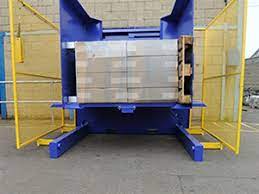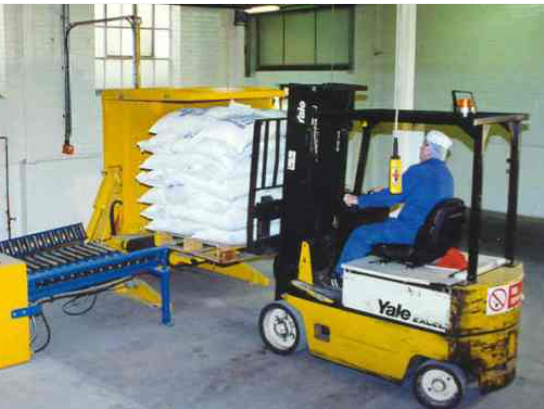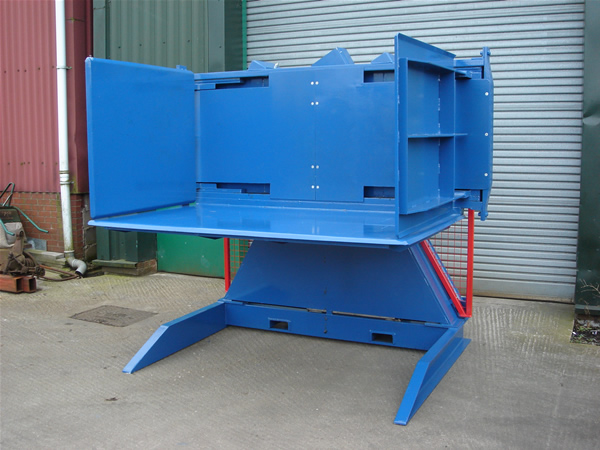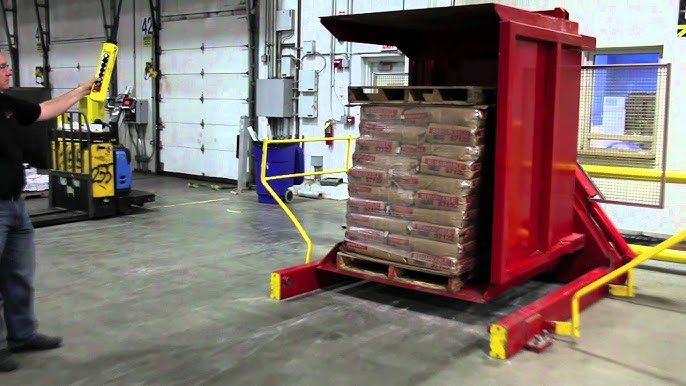Choosing the Right Pallet Inverter for Indonesia's Demands in Worker Safety Amid Rising Logistics Demand
Indonesia's logistics industry is growing at an incredible speed. This boom is creating amazing opportunities for businesses. But it also creates immense pressure. Warehouses are busier than ever. The demand for speed and efficiency is high. This often leads companies to rely on manual labor for tasks like transferring goods between pallets. This is a big problem. Manual handling is slow, inefficient, and, most importantly, dangerous. It puts your workers at constant risk of injury.
These risks are not just theoretical. I've seen them firsthand. A strained back, a crushed foot, or chronic pain from repetitive lifting can take a valuable employee out of action for weeks. This leads to production delays, worker compensation claims, and a drop in team morale. The pressure to keep up with demand can inadvertently create an unsafe and unsustainable work environment. This is where a strategic investment in technology becomes not just an advantage, but a necessity. The right equipment can solve these problems, protecting your people and your profits.
Choosing the right pallet inverter for Indonesia involves a careful analysis of your specific load requirements, available operational space, and desired throughput speed. The key is to select a model with robust, modern safety features like full guarding, light curtains, and intuitive controls. This directly addresses the country's rising standards for worker safety, which is a major concern in the fast-paced logistics sector. It's a decision that balances productivity with the well-being of your team.

Making this choice can feel overwhelming. There are many types of pallet inverters, each with different features and benefits. It's not just about buying a piece of machinery. It's about understanding how that machine will integrate into your specific workflow in your Indonesian facility. It's about finding a solution that solves your immediate challenges and supports your long-term growth. Let's break down the critical questions you need to ask to ensure you make the right choice for your business, your workers, and your future.
How do pallet inverters directly improve worker safety in a busy Indonesian warehouse?
Think about the physical toll of a typical warehouse job. Your workers are constantly bending, lifting heavy boxes, and twisting to move goods from one pallet to another. This is a recipe for disaster. Every manual lift is a potential injury waiting to happen. Over time, this repetitive strain leads to chronic back problems and other musculoskeletal disorders (MSDs), which are the most common and costly workplace injuries.
The financial and human cost of these injuries is staggering. You face lost workdays, higher insurance premiums, and the constant challenge of replacing experienced workers who are out on medical leave. It creates a cycle of inefficiency and risk that holds your business back. A pallet inverter is the solution that breaks this cycle. It takes the human body out of the most dangerous part of the equation.
A pallet inverter improves worker safety by completely automating the physical task of load transfer. Instead of a team of workers manually unstacking and restacking a pallet, a single operator can use the machine to securely clamp and rotate the entire load. This process eliminates the hazardous manual lifting, bending, and twisting that cause the vast majority of warehouse injuries. By mechanizing this task, you create a fundamentally safer work process, protecting your employees from both sudden accidents and long-term strain.

A Focus on Ergonomics and Injury Prevention
The core benefit of a pallet inverter is improved ergonomics. Ergonomics is the science of designing the workplace to fit the worker, not forcing the worker to fit the job. Manual pallet handling is a perfect example of poor ergonomics. A worker might lift hundreds of items per shift, many weighing over 15-20 kg. This repetitive strain on the spine, shoulders, and knees is unsustainable. The result is a high incidence of MSDs.
A pallet inverter transforms this process. The machine does all the heavy lifting. The operator's job shifts from manual labor to supervision and control, often from a safe distance using a simple control panel. This drastic reduction in physical strain is the single most effective way to prevent MSDs in a logistics environment. In a market like Indonesia, where the workforce is young and growing, establishing safe working practices early on is critical. It builds a reputation as a good employer, which helps attract and retain talent in a competitive market. It's an investment in the health of your people and the health of your business.
Creating a Safer and More Organized Environment
The safety benefits go beyond just preventing lifting injuries. Manual unloading and restacking is often a chaotic process. It can lead to unstable stacks of goods, cluttered floor space, and an increased risk of items falling. This creates tripping hazards and other dangers. A pallet inverter contains the entire process within the machine's footprint. The load is securely clamped at all times, preventing spills and product damage.
I remember visiting a client's warehouse in Jakarta a few years ago. They were growing fast to meet e-commerce demand, and their operations floor was a mess. They had three serious back injury claims in less than six months. The mood was tense. We didn't just sell them a machine. We analyzed their entire receiving and shipping process. We recommended a 180-degree freestanding inverter that could be loaded by a forklift. After installation and training, the change was incredible. The floor was clearer, the process was smoother, and six months later, they had zero new back injury reports. Their throughput even increased by 15% because the process was so much more predictable and efficient.
What are the critical technical specifications to consider for Indonesia's diverse logistics needs?
You see a pallet inverter, and it seems simple. It turns things upside down. But choosing the wrong machine is a costly mistake. You might buy an inverter that can't handle the weight of your products, or one with clamps that damage your fragile goods. It might be too slow for your high-volume operation or too large for your limited floor space.
This is a problem I've seen many times. A business owner makes a quick decision without a deep analysis, and they end up with a machine that becomes a bottleneck instead of a solution. It sits in a corner, unused, a monument to a poor investment. To avoid this, you must approach the selection process with a clear understanding of your specific operational reality. You need to dig into the technical specifications and match them precisely to your needs.
The most critical technical specifications for a pallet inverter are its load capacity, clamping pressure system, rotation method, and cycle time. You must evaluate these against the reality of your products and workflow. Indonesia's economy is diverse, handling everything from heavy industrial goods to delicate food products and fast-moving consumer goods. The right machine for a steel parts distributor will be very different from the right machine for a pharmaceutical company. Matching the specs to the job is the foundation of a successful investment.

Load Capacity and Clamping Pressure
The first question is always: what are you moving? You need to know the maximum weight and dimensions of your pallets. Always choose a machine with a load capacity that is at least 10-15% higher than your heaviest pallet. This provides a crucial safety margin and ensures the machine is not constantly working at its absolute limit, which reduces wear and tear.
Just as important is the clamping system. This is what holds your product securely during the rotation. A basic system might have a fixed pressure, which is fine for robust goods like bags of cement or canned drinks. But if you are handling fragile items, like electronics in cardboard boxes or glass bottles, you need a system with adjustable pressure control. Modern inverters use hydraulic systems that allow the operator to dial in the precise pressure needed. Too little pressure, and the load can shift. Too much pressure, and you will crush your own products. For a business dealing with a variety of goods, a machine with a sensitive, adjustable clamping system is not a luxury; it is essential for preventing damage and waste.
Choosing the Right Type of Inverter
Pallet inverters are not one-size-fits-all. The type of machine you choose depends heavily on your facility's layout, workflow, and volume. Here is a simple breakdown of the most common types:
| Feature | 180° Free-Standing Inverter | 90° Tipper / Tilter | Inline Conveyor System |
|---|---|---|---|
| Best For | High flexibility, various load types. Loaded by forklift. | Transferring loads to shipping containers or changing pallets when space is tight. | Fully automated, high-speed production or distribution lines. |
| Footprint | Medium to Large | Small to Medium | Very Large (part of a line) |
| Integration | Standalone, easy to add to existing layouts. | Can be standalone or integrated into a small conveyor. | Requires full integration into an automated conveyor line. |
| Worker Interaction | Low, primarily the forklift operator. | Moderate, operator often manages the pallet exchange. | Minimal, fully automated process. |
| Typical Use Case | Cold storage facilities, general distribution centers, food production. | Loading export containers, sorting centers. | High-volume beverage plants, automated warehousing. |
For many businesses in Indonesia, a 180° free-standing model offers the best balance of flexibility and performance. It can be placed anywhere on the warehouse floor and handle a wide variety of products. A 90° tipper is an excellent, cost-effective solution for businesses focused on loading goods for export or for operations where floor space is a major constraint. Fully automated inline systems are for the largest players who need to process hundreds of pallets per hour with minimal human touch.
How can a pallet inverter provide a strong Return on Investment (ROI) amid rising operational costs in Indonesia?
Every business owner, especially in a competitive market like Indonesia, looks at new equipment through the lens of cost. A pallet inverter is a significant capital expenditure. It's easy to see the price tag and hesitate. You might think, "We are managing with manual labor now, why change?"
But this view is shortsighted. The true cost of your current operation is hidden. It lies in the inefficiencies, the risks, and the hidden expenses that eat away at your profit margin every single day. The cost of labor is rising. The cost of product damage is high. The cost of a workplace injury can be devastating. When you look at it this way, not investing in modern equipment is the more expensive choice. A pallet inverter isn't a cost center; it's a profit center that pays for itself much faster than you might think.
A pallet inverter delivers a strong and measurable ROI by directly attacking your biggest operational costs. It drastically reduces the need for manual labor for pallet exchange tasks, cuts down on expensive product damage, and virtually eliminates the costs associated with lifting-related worker injuries. At the same time, it increases your operational speed, allowing you to move more goods with the same or fewer people. This combination of cost reduction and throughput enhancement is how the machine pays for itself and starts generating profit for your business.

Calculating Your Tangible Savings
Let's make this real. You don't have to guess at the ROI. You can calculate it. Start with labor. How many workers does it take to manually transfer one pallet, and how long does it take? Let's say it takes two workers 20 minutes. A pallet inverter can do the same job with one operator in under two minutes. Calculate the number of pallets you transfer per day, and you can see the massive savings in man-hours. These are hours your team can now spend on more value-added tasks like picking, packing, and quality control.
Next, look at product damage. What is your current rate of damage during manual handling? Even a conservative 1% damage rate on high-value goods adds up to a huge number over a year. A pallet inverter handles the load smoothly and securely, which can cut that damage rate by 70-80% or more. Finally, consider the cost of injuries. The average cost of a single serious back injury claim, including medical bills and lost work time, can easily exceed the cost of the machine itself. Preventing just one such injury can mean the machine has already paid for itself.
Unlocking Intangible Value and New Opportunities
The ROI isn't just about the costs you avoid. It's also about the new opportunities you create. For example, many companies in Indonesia receive goods on high-quality, expensive rental pallets but want to ship them out on cheaper, one-way pallets. A pallet inverter makes this switch effortless. The savings from this "pallet management" strategy alone can be enormous.
I learned this lesson early in my career when building my own factory. We invested in automated coil handling equipment. On the surface, it was to move steel faster. But the real ROI came from something else. The automated system handled the steel coils so gently that it eliminated the edge damage we used to get from crane hooks and forklifts. This improved our product quality, reduced scrap, and made our customers happier. The ROI was not just in speed, but in quality and risk reduction. The same principle applies to a pallet inverter. It's a tool for efficiency, yes, but it is also a tool for quality, safety, and operational excellence. It makes your business stronger, more resilient, and more profitable.
Why is choosing a supportive supplier as important as the machine itself for success in Indonesia?
You've done your research. You've analyzed your needs and selected the perfect pallet inverter with all the right specifications. The machine arrives. It's sitting on your warehouse floor. Now what? Who will install it correctly and safely? Who will train your operators to use it efficiently? And most importantly, who will you call when you need a spare part or technical support six months or two years from now?
This is a critical moment that many business owners overlook. They focus so much on the machine itself that they forget about the partner who provides it. The machine can be the best in the world, but without proper support, it can quickly become a very expensive piece of useless metal. A machine sitting idle because of a minor fault or an untrained operator is a huge drain on your investment. That's why I always say that the supplier is just as important as the product.
Choosing a supportive supplier is non-negotiable for achieving long-term success with your equipment in Indonesia. A good supplier acts as a true partner. They provide expert installation to ensure the machine runs perfectly from day one. They offer comprehensive training so your team can operate it safely and productively. And crucially, they provide responsive, local after-sales service and have spare parts readily available. This partnership is what guarantees your machine's uptime, performance, and ultimate return on investment.

The Critical Need for Local Support
Indonesia is a vast country. If your supplier's service hub is in Europe or even another part of Asia, you are setting yourself up for failure. When you have a problem, you can't afford to wait days for a response to an email or weeks for a spare part to clear customs. You need a partner with a local or regional presence. Someone who understands the local market, speaks the language, and can have a technician at your facility quickly.
Before you buy, ask the hard questions. Where is their service team based? What is their guaranteed response time? Where are their spare parts warehoused? A supplier who cannot give you clear, confident answers to these questions is a major risk. A reliable partner will have a support infrastructure in place, ready to help you when you need it most. This is the difference between a minor hiccup and a major shutdown.
Beyond the Sale: A Strategic Partnership
This is the core philosophy behind my own company, SHJLPACK. My slogan is "TOTAL SOLUTION FOR WRAPPING MACHINE" because I learned that selling a machine is easy, but providing a real solution is what builds a lasting business. My journey from being an engineer to a factory owner taught me the value of partnership. I succeeded because I had mentors and partners who shared their knowledge with me.
Now, my mission is to do the same for my clients. I see every interaction as an opportunity to share my expertise. I don't want to just sell you a pallet inverter. I want to help you understand how to optimize your entire packaging and handling line. I want to be the person you call for advice on future challenges, whether it's about digital transformation or meeting new environmental standards. When you are looking for a supplier, look for this mindset. Are they just trying to make a sale, or are they genuinely invested in helping your business grow? Choose the partner, not just the product. That is the secret to long-term success.
Conclusion
In conclusion, selecting the right pallet inverter for Indonesia is a strategic decision that boosts safety, efficiency, and your bottom line, securing your business's competitive edge.




